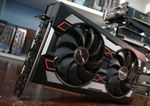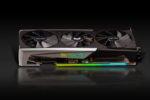Most people play on 1080p monitors and aspire to game in 4K, but here in 2019, 2560×1440 resolution is the PC gaming sweet spot. 1440p provides a big leap in visual fidelity over 1080p, yet it won’t melt your graphics card as ferociously as a 4K display.
Picking the best 1440p graphics card can be somewhat complicated however. Here, you’ll start to see a wider array of monitor types and features than you typically do at 1080p resolution, with ultra-wide resolutions and high refresh rates becoming much more common. You need to keep the specifics of your setup in mind when you’re buying a new GPU. This guide can help.
If you want a wider look at the world of GPUs, be sure to check out our overarching guide to the best graphics cards for PC gaming, where we also explore your best video options for 1080p and 4K resolution, and divvy out buying tips to keep in mind while you’re on the hunt for new hardware.
The best 1440p graphics card: AMD Radeon RX 5700
The Radeon RX 5700 delivers excellent gaming performance and power efficiency while moving the goal posts forward on several technological fronts.
Your best option for PC gaming at 1440p resolution on a standard 60Hz display is the AMD Radeon RX 5700, which ostensibly starts at $350 but can often be found at $330 on the street—and sometimes less, if you catch a particularly enticing sale.
The Radeon RX 5700 has no problem clearing the 60-frames-per-second gold standard in the vast majority of modern games. There are games where it does fall a few frames short: Some titles, like Metro Exodus, have especially strenuous high-end graphics presets designed to bring modern hardware to its knees, in Crysis-like fashion. In such cases, bumping a couple of visual settings from Ultra down to High or Very High should do the trick. AMD stuffed the card with 8GB of ultra-fast GDDR6 memory, which should be enough for 1440p-resolution gaming for years to come.
This card was the first GPU built using 7nm process technology and AMD’s new “RDNA” graphics architecture (which was since trickled down to the Radeon RX 5500 XT and RX 5600 XT). The underlying tweaks helped AMD finally draw equal to Nvidia’s impressive power efficiency. Games that once favored Nvidia’s GeForce architectures now perform much better on the Radeon RX 5700. It also supports the bleeding-edge PCIe 4.0 interface if you’re running a system with an AMD Ryzen 3000 processor paired with an X570 motherboard, though the benefits from that will be more apparent in select content creation workloads than during gameplay.
Add it all up and the Radeon RX 5700 is the best graphics card for 1440p gaming at 60 frames per second.
The Radeon RX 5700 already provided stunning value for 1440p gamers. Sapphire’s custom Pulse RX 5700 builds atop that for just $9 more, and pushes performance even further with its excellent Trixx Boost upscaling.
Custom versions like the Sapphire Pulse Radeon RX 5700 deliver big improvements in thermals and acoustic performance, while providing other nice quality-of-life features such as a mild out-of-the-box overclock, a metal backplate, and a dual-BIOS switch with Performance and Quiet profiles. It costs $360, a mere $10 premium over the reference model MSRP. Other custom Radeon RX 5700 models cost the same or more depending on their feature set.
Lower budget graphics card for 1440p gaming
The Radeon RX 5700 may be the best 1440p graphics card for most people, but it isn’t your only option.
If the Radeon RX 5700’s $350 price tag is a bit too rich for your blood, Nvidia’s $230 GeForce GTX 1660 Super—our favorite 1080p graphics card—could also handle 1440p gaming if you don’t mind making visual sacrifices to achieve 60 fps. The GTX 1660 Super is a lot slower than the Radeon GPU, however, and the card’s 6GB of memory may not hold up well for top-quality 1440p gaming over the long haul, though it’s (mostly) fine today.
That’s worth diving deeper into. Most of the cards that come cheaper than the Radeon RX 5700 make memory compromises, typically offering 6GB of GDDR6. That’s perfect for 1080p gaming, but the limited RAM buffer may force you to drop texture quality and other memory-intensive graphics options in especially strenuous games. Playing with a mixture of Medium to High settings reduces memory demands though, and you may have to do that for the best frame rates with these more mainstream-priced cards. Part of the reason we like the Radeon RX 5700 is its spacious 8GB capacity.
The AMD Radeon RX 5600 XT delivers outstanding 1080p gaming, knocking out the GeForce GTX 1660 Ti thanks to a last-minute BIOS upgrade. The need to install that upgrade manually and price cuts from rival Nvidia cards takes off some of its shine, though.
The $280 GeForce GTX 1660 Ti is faster than the GTX 1660 Super, and it holds a welcome 8GB of RAM. But it’s hard to recommend over AMD’s identically priced Radeon RX 5600 XT, which is even faster for the same price despite only having 6GB of GDDR6 memory. It’s essentially a Radeon RX 5700 with slower clock speeds and slower, less spacious memory.
Shop smart if you decide to go this route though: AMD released a last-second BIOS upgrade for the card that means some Radeon RX 5600 XT models are much faster than others. We can specifically (and highly) recommend the Sapphire Pulse version, which comes with the fastest speeds allowed by AMD with a whisper-quiet cooler for a mere $10 price premium.
The EVGA GeForce RTX 2060 KO makes some smart compromises to bring real-time ray tracing under $300, drastically undercutting its rivals.
If you’re fine with spending around $300, and don’t mind dropping down to 6GB of RAM, you can consider Team Green. In response to the Radeon RX 5600 XT’s launch, Nvidia dropped the price of its GeForce RTX 2060 Founders Edition to $300, and EVGA rolled out the fantastic $300 GeForce RTX 2060 KO. It’s much more compelling at that price than the usual $350, and worth your money if you absolutely can’t spend more than $300 overall, but we recommend saving your lunch money for a few more weeks to get the Radeon RX 5700 if possible.
AMD’s card is faster and has a more robust memory configuration than the Nvidia GPU. The main reason to consider the RTX 2060 is if you want to buy into the real-time ray tracing support that’s currently supported only on Nvidia’s RTX 20-series graphics cards. (Ray tracing provides gorgeous lighting effects at a significant frame rate penalty.) Even so, we wouldn’t recommend it, as the RTX 2060’s ray tracing capabilities lag far behind those of its sibling cards.
The best 1440p graphics cards for high refresh rate monitors
If you want to invest in ray tracing, we’d suggest buying at least a $400 GeForce RTX 2060 Super, but that card’s only marginally faster than the Radeon RX 5700 we recommend above. You’re investing an extra $50-plus into the ray tracing promise, essentially. Only a handful of games currently support the technology, though several blockbuster games—such as Cyberpunk 2077 and Doom Eternal—have pledged to do so in the future.
The Sapphire Nitro+ Radeon RX 5700 XT delivers excellent performance that’s pushed even further with some smart software tricks, and the graphics card’s hardware design is so thoughtful it’s virtually flawless. We can’t think of anything we’d change.
But $400 can give you a bigger performance boost in 1440p gaming if you stick with AMD. Its $400 Radeon RX 5700 XT offers just shy of 10 percent higher overall performance than the RTX 2060 Super, though that fluctuates depending on the game engine. It doesn’t support ray tracing, but it does come close to the performance of the $500 GeForce RTX 2070 Super, falling only about 5 to 6 percent shorter overall, and damned near even in several titles. The Radeon RX 5700 XT serves as a sort of spoiler for both the RTX 2060 Super and 2070 Super, and it’s a great 1440p gaming option at high refresh rates (think 120Hz or 144Hz).
We’ve reviewed high-performing custom designs in the Sapphire Nitro+ and XFX Thicc III Ultra. Again, both are well worth the extra investment if you can swing it.
That said, the GeForce RTX 2070 Super delivers the best 1440p gaming performance and the best ray tracing performance of the bunch. Whether that’s worth an extra $100 over the Radeon RX 5700 XT (and $150-plus over the Radeon RX 5700) is up to you, and how quickly you feel real-time ray tracing will be adopted. All the cards discussed here that cost $400 and up give you 8GB of GDDR6 RAM, a.k.a. the 1440p sweet spot.
If you absolutely, positively want to eke as much performance as possible out of a high refresh-rate 1440p monitor, you could step up to the $700 GeForce RTX 2080 Super, though that’s a bit overkill for most people, especially since the RTX 2070 Super gets pretty close to its performance for $200 less. The GeForce RTX 2080 Super could be a good option for 3440×1440 ultrawide monitor users, though.
How to check your monitor’s refresh rate
A lot of this advice revolves around the refresh rate of your monitor. The faster your monitor refreshes, the faster the graphics card you can use.
None of the 1440p graphics cards mentioned today could feed this 4K, 120Hz display well.
If you aren’t sure how fast your monitor is, click the Start button in the lower-left corner of the Windows 10 taskbar, the head to Options gear > System > Display. Scroll down past where you see the resolution for your monitor(s) listed, then click Advanced display settings at the bottom of the page. You’ll see more detailed stats for your display listed, including the refresh rate in hertz (Hz). If you have multiple monitors, you’ll be able to switch between them.
Some monitors can run at different speeds depending on their settings. To see what’s available for yours, click the Display adapter properties link at the bottom of this page, then click on the Monitor tab in the new box that appears. It’ll house a drop-down menu with your available screen refresh rates. If what you see appears slower than what your monitor should be capable of, you might need to dive into the options menu for your specific monitor, which is accessible via hardware buttons on your display.
Got it? Good. Again, if you’re buying from scratch and wondering which sort of setup is right for you, be sure to check out our guide to the best graphics cards for PC gaming to see the best GPU options for 1080p and 4K resolutions.
Source: Read Full Article





